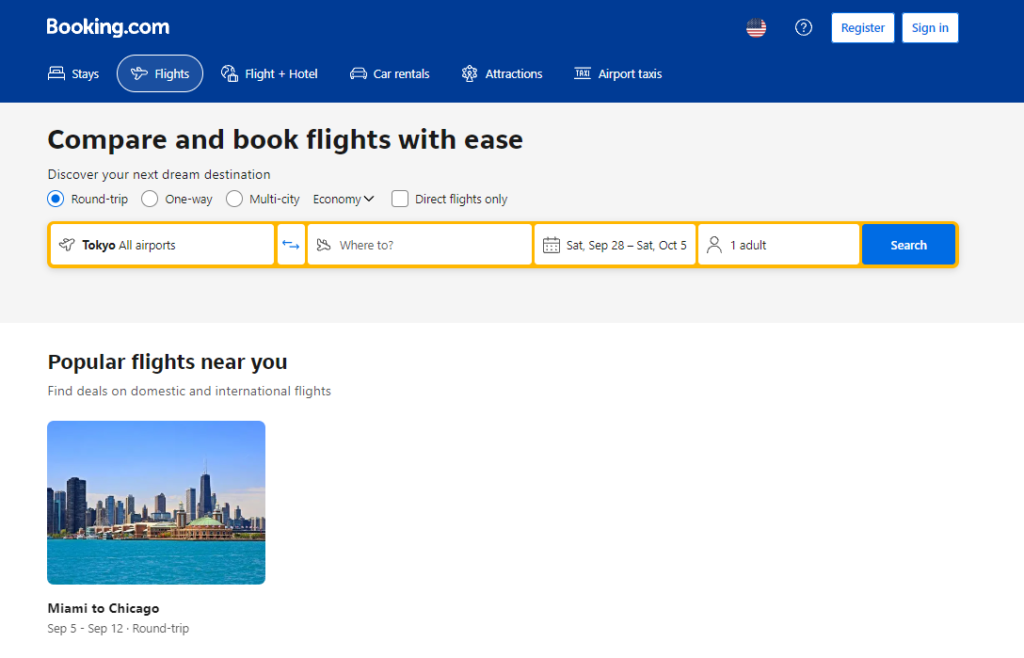Master booking an airline ticket online with our comprehensive ESL guide. Enhance your English conversation skills for ESL intermediate English learners, perfect for booking a flight and navigating online travel reservations. This effortless guide offers 7 essential tips, key vocabulary, and step-by-step instructions for confident travel planning. From choosing the best fares to understanding airline jargon, we’ve got you covered. Booking an airline ticket has never been easier! Ideal for ESL students looking to improve their travel-related English.
Table of Contents
- Introduction to Booking an Flight Online
- Essential Vocabulary for Online Flight Booking
- Common Phrases Used in Booking a Flight
- Step-by-Step Guide to Booking a Flight Online
- Practice Conversation: Booking a Flight Online
- Tips for a Smooth Online Booking Experience
- Advanced Booking Strategies for Savvy Travelers
- Troubleshooting Common Issues When Booking Online
- Cultural Considerations in International Travel Booking
- The Future of Online Flight Booking
- Conclusion and Call to Action
1. Introduction to Booking a Flight Online
In today’s digital age, booking a flight online has become an essential skill for travelers worldwide. For ESL learners at an intermediate level, mastering the vocabulary and phrases used in this context is crucial for confident and stress-free travel planning. This comprehensive guide will walk you through the entire process, ensuring that you feel empowered to book your next flight with ease.
As the world becomes increasingly interconnected, the ability to navigate online booking systems is not just convenient—it’s necessary. Whether you’re planning a business trip, a family vacation, or an adventure abroad, understanding how to book your own flights gives you greater control over your travel experience and can often lead to significant cost savings.
If you want to a YouTube video of a conversation, click here or click on the video.
Answers to the Listening Test: 1) B 2) D 3) A 4) B 5) D 6) C 7) D
2. Vocabulary for Booking an Flight Online
Before diving into the booking process, let’s familiarize ourselves with key terminology you’ll encounter when booking an airline ticket online. Understanding these words will help you navigate the booking process with confidence:
- Round-trip ticket: A ticket that allows you to travel to a destination and return.
- One-way ticket: A ticket for travel to a destination without a return flight.
- Departure: The act of leaving, usually referring to your flight leaving the airport.
- Arrival: The act of coming to a place, usually referring to your flight landing.
- Connecting flight: A flight that requires you to change planes before reaching your final destination.
- Layover: A period of waiting between connecting flights.
- Economy class: The cheapest and most common class on a plane.
- Business class: A more expensive class offering more comfort and amenities.
- First class: The most expensive and luxurious class on a plane.
- Baggage allowance: The amount of luggage you are allowed to take on a flight.
- E-ticket: An electronic version of a paper ticket.
- Check-in: The process of registering for your flight at the airport or online.
- Boarding pass: A document that allows you to board the plane.
- Gate: The area in an airport where you board your flight.
- Itinerary: A detailed plan or schedule of your journey.
- Frequent flyer program: A loyalty program offered by airlines to reward regular customers.
- Travel insurance: A type of insurance that covers unforeseen events during your trip.
- Booking reference: A unique code that identifies your flight reservation.

3. Common Phrases Used in Booking a Flight
When booking a flight online, you will encounter several common phrases. Familiarize yourself with these to make the process smoother.
- “I would like to book a round-trip ticket to [destination].”
- “What is the best price for a one-way ticket?”
- “Can I change my booking later?”
- “What is the baggage allowance for this flight?”
- “Is there a direct flight to [destination], or will I need a connecting flight?”
- “Can I choose my seat now?”
- “What is the cancellation policy for this ticket?”
- “Are there any discounts available for students/seniors?”
- “How much is the fee for extra baggage?”
- “Can I earn frequent flyer miles on this flight?”
- “What time do I need to arrive at the airport for check-in?”
- “Is online check-in available for this flight?”

4. Step-by-Step Guide to Booking a Flight Online
Now, let’s walk through the process of booking an airline ticket online, step by step:
Step 1: Choose Your Flight
When booking an airline ticket online, the first step is to choose your flight. Begin by selecting whether you want a round-trip or one-way ticket. Then, enter your departure and destination cities, along with your travel dates.
Begin by selecting whether you want a round-trip or one-way ticket. Enter your departure and destination cities, along with your travel dates.
Example: If you want to fly from New York to London, enter “New York” as your departure city and “London” as your destination.
Step 2: Compare Prices
Once you’ve entered your travel details, you’ll see various flight options. Compare prices, times, and airlines to choose the best option for your needs and budget.
Tip: Look out for additional fees, such as baggage fees, which might not be included in the initial price.
Step 3: Select Your Flight
After comparing options, select the flight that best suits your needs. Review the flight details carefully, including departure and arrival times, layovers, and total travel time.
Example: “I’m choosing the 10:00 AM direct flight from New York to London.”
Step 4: Enter Passenger Information
Next, enter the passenger information. This typically includes your full name, date of birth, and passport details for international flights. Ensure the information matches exactly with your travel documents.
Example: “I will enter my full name as it appears on my passport: John Michael Doe.”
Step 5: Choose Your Seat and Add Extras
Most airlines allow you to choose your seat during the booking process. You can also add extras, such as additional baggage, meals, or travel insurance.
Example: “I’d like to choose a window seat and add one checked bag.”
Step 6: Payment and Confirmation
Finally, enter your payment details to complete the booking. After payment, you will receive a confirmation email with your e-ticket and flight details.
Tip: Double-check all the details before completing your purchase to avoid any issues later.

5. Practice Conversation: Booking a Flight Online
Let’s practice a conversation where you book a flight online. This exercise will help you feel more confident when you actually make your booking:
Travel Agent: “Welcome to XYZ Airlines. How can I assist you today?”
Customer: “Hi, I’d like to book a round-trip ticket from New York to London.”
Travel Agent: “Certainly! What dates are you looking to travel?”
Customer: “I’d like to depart on October 10th and return on October 20th.”
Travel Agent: “Let me check availability for those dates… I have a direct flight available for $500. Would you like to proceed with this option?”
Customer: “Yes, that sounds good. Can I choose my seat now?”
Travel Agent: “Of course! Which seat would you prefer? We have window, aisle, and middle seats available.”
Customer: “I’d like a window seat, please.”
Travel Agent: “Excellent choice. I’ve reserved a window seat for you. Now, would you like to add any extras to your booking, such as additional baggage or travel insurance?”
Customer: “No, thank you. The standard baggage allowance should be sufficient.”
Travel Agent: “Very well. Your total comes to $500. I’ll just need your payment details to complete the booking. Once the payment is processed, I’ll send you a confirmation email with your e-ticket and all the flight details.”
Customer: “Great, thank you for your help!”
6. Tips for a Smooth Online Booking Experience
To ensure a hassle-free booking process, keep these tips in mind:
- Compare Prices Across Websites: Use comparison sites to find the best deals across multiple airlines.
- Check for Hidden Fees: Always review the final price to see if there are additional fees for baggage, seats, or other services.
- Review Cancellation Policies: Understand the airline’s cancellation and change policies before booking, especially if your travel plans might change.
- Keep a Copy of Your Confirmation: Save or print a copy of your e-ticket and confirmation email for easy reference.
- Use Incognito Mode: When searching for flights, use your browser’s incognito or private mode to potentially avoid price increases based on your search history.
- Be Flexible with Dates: If possible, check prices for different dates around your preferred travel time. Sometimes, flying a day earlier or later can result in significant savings.
- Sign Up for Airline Newsletters: Many airlines offer exclusive deals to their email subscribers.
- Check for Promo Codes: Before finalizing your booking, search online for any available promo codes that could save you money.
7. Advanced Booking Strategies for Savvy Travelers
As you become more comfortable with online booking, consider these advanced strategies to maximize your travel experience and potentially save money:
- Utilize Frequent Flyer Programs: Sign up for airline loyalty programs to earn miles on your flights, which can be redeemed for future travel or upgrades.
- Consider Nearby Airports: Sometimes, flying into or out of a nearby airport can be significantly cheaper. Be sure to factor in transportation costs to your final destination.
- Book at the Right Time: While there’s no perfect time to book, generally, booking 6-8 weeks before domestic flights and 3-4 months before international flights can offer good prices.
- Use Flight Price Prediction Tools: Some travel websites offer tools that predict whether flight prices are likely to rise or fall in the near future.
- Mix and Match Airlines: Sometimes, booking your outbound and return flights with different airlines can result in savings.
- Consider Budget Airlines: For shorter flights, budget airlines can offer significant savings, but be sure to read the fine print regarding baggage and other fees.
- Use Credit Card Travel Rewards: Many credit cards offer travel points or miles that can be used to book flights or upgrade your travel experience.
8. Troubleshooting Common Issues When Booking Online
Even with careful planning, you might encounter some issues when booking flights online. Here’s how to handle common problems:
- Payment Declined: If your payment is declined, first check that you’ve entered all information correctly. If the problem persists, contact your bank to ensure there are no issues with your card.
- Website Crashes: If the airline’s website crashes during your booking, wait a few minutes and try again. If the problem continues, try using a different browser or device.
- Price Changes: If you notice the price has changed between searches, try clearing your browser cookies or using incognito mode.
- Booking Confirmation Not Received: If you don’t receive a booking confirmation email, check your spam folder. If it’s not there, contact the airline’s customer service with your booking reference.
- Incorrect Information Entered: If you realize you’ve entered incorrect information after booking, contact the airline immediately to correct it. Some airlines allow minor corrections for free within 24 hours of booking.
Remember, if you encounter any issues you can’t resolve on your own, don’t hesitate to contact the airline’s customer service for assistance.
9. Cultural Considerations in International Travel Booking
When booking international flights, it’s important to be aware of cultural differences that might affect your travel plans:
- Date Formats: Be mindful of different date formats (DD/MM/YYYY vs. MM/DD/YYYY) to avoid booking for the wrong date.
- Time Zones: When booking connecting flights, pay attention to time zones to ensure you have enough time for layovers.
- Name Order: Some cultures place the family name first. Make sure you enter your name exactly as it appears on your passport.
- Holidays and Festivals: Be aware of major holidays or festivals at your destination, as these can affect flight prices and availability.
- Visa Requirements: Check visa requirements for your destination and any countries you’ll be transiting through. Some airlines won’t let you board without proper documentation.
- Meal Preferences: Many airlines offer meals that cater to different cultural or religious dietary requirements. Don’t forget to specify your preference during booking if needed.
Being aware of these cultural considerations can help you avoid misunderstandings and ensure a smoother travel experience.
10. The Future of Online Flight Booking
As technology continues to advance, the process of booking flights online is likely to become even more streamlined and personalized. Here are some trends to watch for:
- AI-Powered Recommendations: Artificial intelligence may soon provide highly personalized flight recommendations based on your past travel history and preferences.
- Virtual Reality Preview: Some airlines are experimenting with VR technology to allow passengers to preview their seats and the aircraft before booking.
- Blockchain for Secure Bookings: Blockchain technology could be used to create more secure and transparent booking systems.
- Voice-Activated Booking: As voice recognition technology improves, you might soon be able to book your flights using voice commands on your smart devices.
- Biometric Check-In: More airports and airlines are adopting biometric technology for check-in and boarding, potentially eliminating the need for physical boarding passes.
- Carbon Offsetting Integration: As environmental concerns grow, more booking platforms may integrate carbon offsetting options directly into the booking process.
Staying informed about these trends can help you adapt to new booking technologies as they become available, ensuring you always get the best possible deals and travel experiences.
11. Conclusion and Call to Action
Booking an airline ticket online doesn’t have to be a daunting task, even for ESL learners. With the right vocabulary, phrases, and strategies at your disposal, you can navigate the process with confidence and ease. Remember, practice makes perfect – the more you engage with online booking systems, the more comfortable you’ll become.
We encourage you to put your new skills to the test! Try booking a flight for your next trip using the steps and tips outlined in this guide. If you encounter any challenges, don’t hesitate to refer back to this resource or seek assistance from the airline’s customer service.
For more practice and to see these concepts in action, watch our YouTube video on “Booking a Flight in English.” This visual guide will reinforce the vocabulary and phrases you’ve learned and give you a real-time look at the online booking process.
Happy travels, and may your future flight bookings be smooth and stress-free!
Call to Action: Ready to become a flight booking pro? Watch our YouTube video on Booking a Flight in English for a visual guide to the process. And don’t forget to check out our other ESL resources to continue improving your English skills for real-life situations. Safe travels!
If you also want to learn English Phrases when you go to the hair salon click here!


